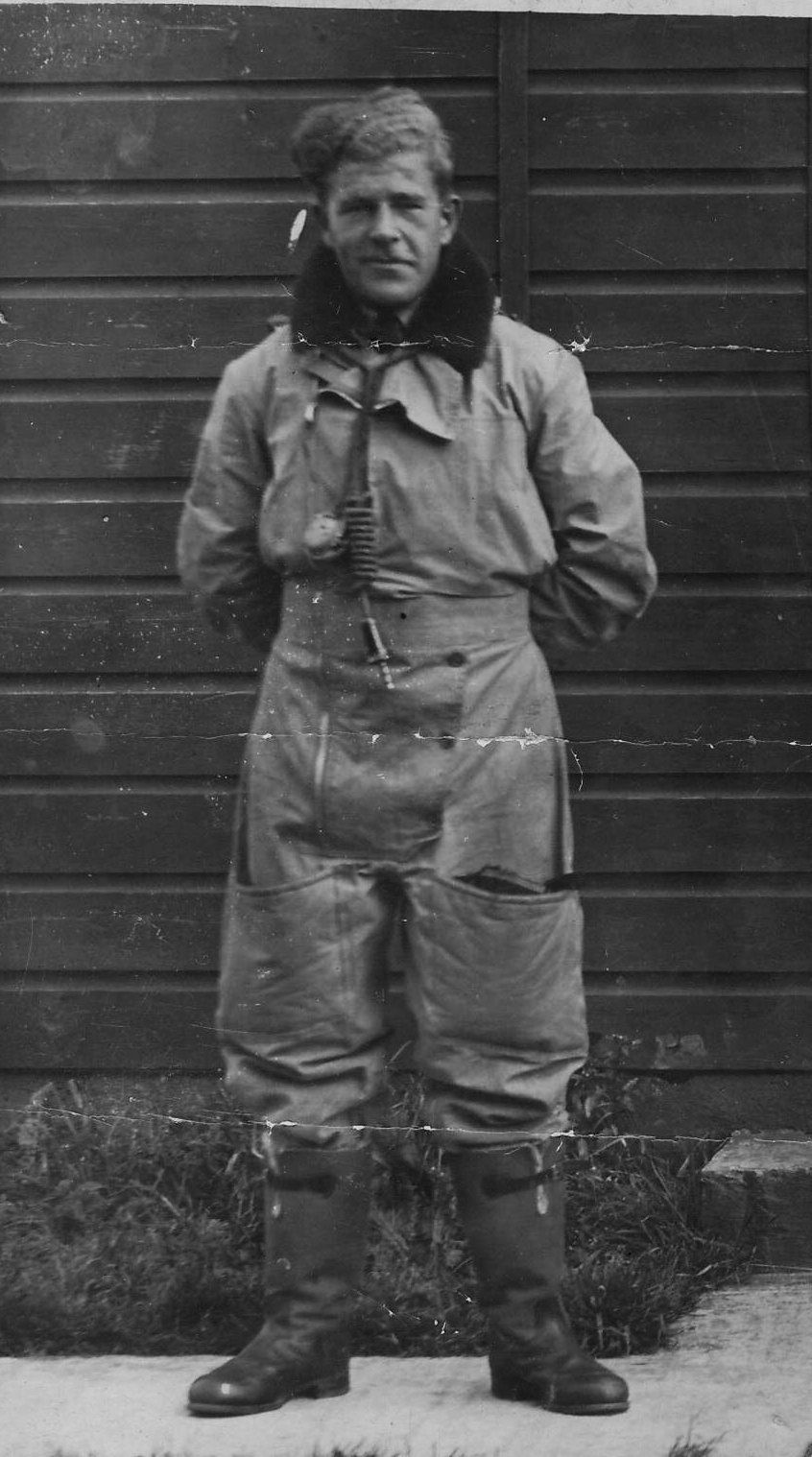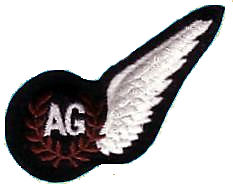|
Cyril Moore

No.11 Operational Training Unit
RAF Bassingbourn
28th August 1941 to 2nd October 1941 Cyril was then posted to No.11 Operational Training Unit (OTU)
at RAF Bassingbourn which is 11 miles south west of Cambridge.
No. 11 Operational Training Unit’s role was to train night
bomber crews. It was equipped with Wellington Bombers. He had to sit an exam. Had he failed this he would have had to return to Scotland and the Air Gunnery School. All the newly qualified aircrew, Pilot, Navigator, Bomb Aimer, Wireless Operator and Air Gunner began working and training together, trying to perfect activities vital to their individual roles. The pilot spent hours and hours taking off and landing during the day and night. Cross-country flights tested the navigator as they incorporated several different turning points that could be situated anywhere in the UK. Along the route they would probably make a dummy bombing attack on a specified town. The wireless operator was tested with various messages.
Cyril would have had to concentrate on using his knowledge of aircraft recognition to estimate exactly where and when to fire his guns. He had to know target's wingspan and line it up in his gun sights against marks. If the target plane had a thirty-foot wingspan when lined up, it would be 300 yards away. He would have to aim thirty yards in front. Cyril was taught that the first thing to do when you saw a German fighter was to fire some rounds at it. It was called it the 'scare burst', some of the German fighters would turn away, but a few kept attacking. Some of them would fly towards a different aircraft looking for a gunner who was asleep.
 As rear gunner, during an attack by enemy fighters, you had to tell the pilot when to dive port and he'd dive that way 1000 feet, then he'd roll over and dive starboard 1000 feet. Then he'd change and come up starboard for 1000 feet and port 1000 feet, so eventually what he was doing in the air was a diamond, which meant he hadn't steered off the route. The idea was that the Germans would have their guns fixed on the wing and by the time they'd had chance to line you up again, you were over on the port side and it took them about another 1000 feet to get you lined up again. After a bit the German fighters would give up and shove off somewhere else. This was called this corkscrewing.
Cyril would often have felt isolated as a rear gunner. He couldn't see anything that was happening at the front of the aircraft and so was oblivious to any danger ahead. His biggest fear was the turret coming away from the main body of the plane so he would occasionally blow into his microphone, checking it was still working, and thus still attached to the rest of the aircraft.
During the bombing run the Wireless Operator had to take three photographs of the target just after the bombs were released and have hit the ground. Failure to take these three photographs would mean that it was not counted as an ‘operation’. It was to stop crews flying to the North Sea, circling round for five or six hours, throwing their bombs away and coming back. A photo flash was dropped just after the bombs to illuminate where the bombs landed.
It was very cold in the rear turret. At high altitude temperatures of –40 degrees were common. Cyril would have to snap off the icicles hanging from his oxygen mask. Rear Gunners had fleece lined electrically heated suits, which sometimes went wrong. A short circuit could cause one of the boots to over heat and burn the wearers foot. They would have to disconnect the suit from the power supply, but then they would start to shiver.
There was not enough space in the turret for the gunner to wear his parachute and operate the turret properly, so the gunner’s parachute was attached to the fuselage just outside the turret. To abandon ship, he had to turn the turret to point forwards, open the door, retrieve his parachute, close the door, rotate the turret until it was fully turned to one side, then open the door and fall backwards out of the turret.
CYRIL'S FLYING LOG
- No. 11 OTU RAF Bassingham 15th September 1941
00.03hrs took off at night in Wellington 4244 flown by Flight Sgt Turner. Posted Air Gunner, DCO, Flying time 2 Hours 15 minutes
16th September 1941
14.03hrs took off in Wellington 4244 flown by Pilot Officer Lowe. Posted Air Gunner, DCO, Flying time 1 Hour 30 minutes
17th September 1941
20.30hrs took off at night in Wellington 2990 flown by Pilot Officer Campbell. Posted Air Gunner, DNCO landed at RAF Steeple Morden, Flying time 2 Hours
18th September 1941
16.35hrs took off in Wellington 4838 flown by Sgt Linehafi. Posted Air Gunner, DCO, Flying time 1 Hour
20th September 1941
14.10hrs took off in Wellington 4336 flown by Pilot Officer Campbell. Posted Air Gunner, DCO, Flying time 2 Hours
22nd September 1941
13.45hrs took off in Wellington 2990 flown by Pilot Officer Campbell. Posted Air Gunner, DCO, Flying time 1 Hour 15 minutes
22nd September 1941
15.25hrs took off in Wellington 2528 flown by Sgt Nubley. Posted Air Gunner, DCO, Flying time 35 minutes
24th September 1941
14.00hrs took off in Wellington 2490 flown by Flight Sgt Turner. Posted Air Gunner, DCO, Flying time 30 minutes
24th September 1941
16.00hrs took off in Wellington 2990 flown by Flight Officer Vernieux. Posted Air Gunner, DCO, Flying time 40 minutes
25th September 1941
11.20hrs took off in Wellington 4536 flown by Sgt Hanlon. Posted Air Gunner, DCO, Flying time 1 Hour
25th September 1941
22.35hrs took off at night in Wellington 1337 flown by Sgt McSparron. Posted Air Gunner, DCO, Flying time 1 Hour
26th September 1941
14.30hrs took off in Wellington 4244 flown by Flight Sgt Smart. Posted Air Gunner, DCO, Flying time 1 Hour 15 minutes
27th September 1941
12.55hrs took off in Wellington 2990 flown by Warrant Officer Buckley. Posted Air Gunner, DCO, Flying time 1 Hour
30th September 1941
09.30hrs took off in Wellington 9905 flown by Pilot Officer Swift. Posted Air Gunner, Fired 2,000 rounds air to air, Flying time 3 Hours 50 minutes
1st October 1941
09.30hrs took off in Wellington 9791 flown by Squadron Leader Kain. Posted Air Gunner, Fired 1,000 rounds air to ground, Flying time 1 Hour 30 minutes
2nd October 1941
14.45hrs took off in Wellington 1149 flown by Flight Officer Hawkins. Posted Air Gunner, DCO Cross Country, Flying time 2 Hours 15 minutes
Cyril's Flying Log Book carries the following
stamp This is to certify that 619449 Sgt Moore CP
has completed No.11 OTU Course with effect 02.10.1941.
No.11 OTU RAF Bassingbourn
Air gunner badge
 On completing this training, Cyril was presented with his Air Gunner wings
He was promoted to Sergeant, with a Sergeant's pay of 8
shillings a day.
|

